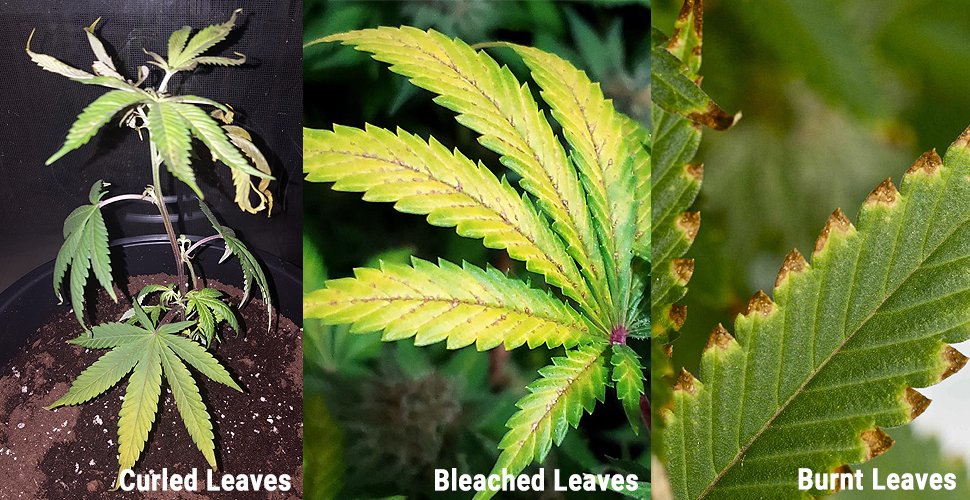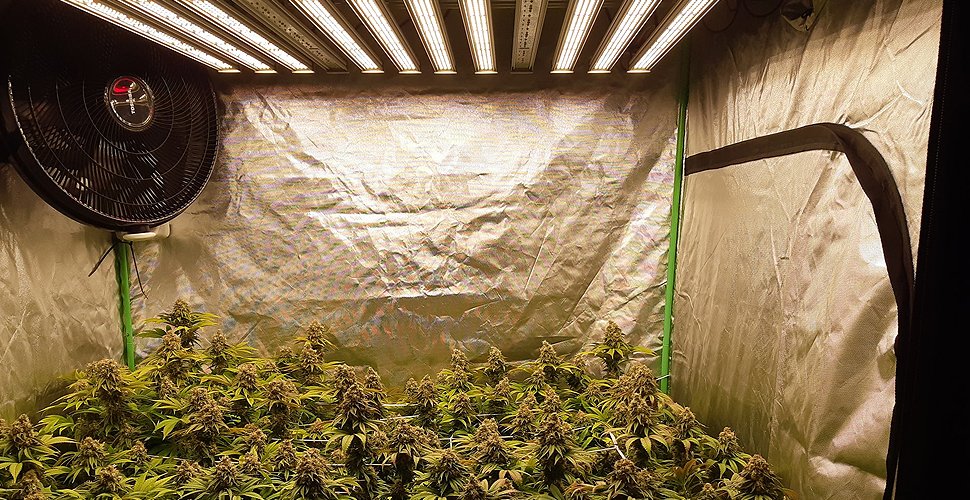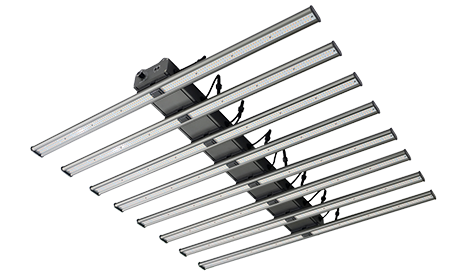Indholdsfortegnelse
Bruger LED vækstlys er en fantastisk måde at dyrke sunde planter indendørs. Mens det siges, at cannabisplanter dyrket under optimale LED-lysforhold kan producere højere knopproduktion, er der ingen grund til at give planten for meget lys. Det ville være kontraproduktivt, og det ville vise tegn på ubehag.
Det er det, mange mennesker bekymrer sig om: om sådanne højtydende LED-dyrelys vil brænde deres planter, som om planterne blev udsat for højintensivt sollys.
Slap af og tag det roligt, lys og varme er faktisk to begreber.
Selvom nogle cannabisdyrkelys kan afgive nok varme til “brænde” planters blade. Men det er varmen fra lampen, der brænder planten, ikke selve lysarmaturen. Så længe lampen er i den rigtige afstand fra planten, er det usandsynligt, at der opstår forbrændinger.
Gå videre og læs videre for at lære mere om om LED-plantelys udgør en risiko for at brænde planter og hvordan man bruger dem rigtigt, såsom hvor tæt skal led-plantelamper være på planter.

Kan LED Grow Lights brænde planter?
LED marihuana vokse lys er de mest pålidelige lys. De har en lavere varmeydelse sammenlignet med traditionelle plantelys. Det er overflødigt at sige, at den lave varme ikke er nok til at brænde planter eller forårsage brand alene.
Men hvis du bruger plantevækstlys af dårlig kvalitet og placerer dem i nærheden af dine planter, kan det føre til bladbrænding og fotoblegning. Oven i købet dine LED vækstlys kan starte en brand på grund af forkerte ledninger, lys af dårlig kvalitet, armaturer osv..
Det kan du undgå ved omhyggeligt at overvåge planterne og lyset og kontrollere, hvor længe planterne er tændt, samt sørge for at havekorrekt afstand-til-watt-forhold.
Tegn på for meget lys på planter
Hvis du er meget opmærksom, vil du se, at de fleste stueplanter faktisk er meget gode til at kommunikere med mennesker. De vil tale med dig om smerte og lykke. Du vil forstå, hvis de bliver skadet af lys, og alt du skal gøre er at sørge for ordentlig belysning til ukrudtsplanter.
Blade med brune eller sorte kanter eller endda begynder at falde af er faktisk planten, der fortæller dig, at du giver for meget og for stærkt lys. Hvis der ikke er nok lys, der når din plante, er gule blade eller visne blade det bedste bevis.
- Brændte blade. Når cannabisplanter udsættes for for meget lys, kan bladene nærmest lyskilden blive forkullede eller misfarvede. Dette kan i sidste ende føre til reduceret fotosyntese og plantevækst.
- Forsinket udvikling. For meget lys stresser planter, hvilket fører til hæmmet vækst og reduceret udbytte. Dette skyldes, at det kan forstyrre plantens evne til at optage næringsstoffer og vand.
- Varmestress. Højintensiv ukrudtsplantebelysning genererer også meget varme, hvilket kan føre til varmestress i cannabisplanter, hvilket får dem til at visne eller endda dø.
- Visnende. Planter, der udsættes for for meget lys, kan blive dehydrerede og visne.
- Blegede Blade. Hvis din plante får for meget direkte lys, kan bladene blive bleget og blive gule eller hvide i farven.
- krøllede blade. Krøllede eller snoede blade kan indikere, at din plante forsøger at undslippe stresset af for meget lys.
- Reduceret blomstring. For meget lys kan forstyrre den hormonbalance, der udløser blomstring, og dermed reducere plantens evne til at blomstre.
Hvis du bemærker nogle af disse tegn i dine planter, ydu skal muligvis juster lysintensiteten for cannabisfrøplanten og lysintensiteten til blomstring. Juster afstanden mellem LED-vokselamperne og dine planter, og flyt derefter planten til et mere skyggefuldt område eller andre beskyttende dæksler.

LED Grow Lights kan brænde planter af en grund
I stedet for at bekymre dig om, at lyset til at dyrke ukrudt brænder dine planter, så tænk bare på, hvad der kan forårsage, at dine cannabisplanter bliver brændt. Der er flere hovedårsager.
LED Grow Lights for tæt på planter
Ligesom sollys har selv LED-lys potentialet til at brænde planter. Når du har mistanke om, at dit vækstlys til cannabis kan være for tæt på dine planter, så tøv ikke med at justere dem på dette tidspunkt.
Hvis dine planter er varme at røre ved, eller jorden ofte tørrer hurtigt ud, er dine vækstlys for tæt på dine planter.
At placere lysene væk fra planten er det vigtigste skridt for at sikre plantens sikkerhed. Hvis planten er placeret mod et vindue, der ville have modtaget mere indirekte sollys, så skal vi justere plantens position og lyset.
Overdreven intensitet
En anden grund til, at planter bliver brændt, er, at intensitetsindstillingen for plantens vækstlys er for høj.
Hvis dit traditionelle vækstlys ikke har en intensitetsindstilling, men det er for tæt på dine planter, så flyt det længere væk. Dagens ukrudtsbladslampe fås med tilfældigt justerbar lysintensitet, designet til at gøre det nemmere for dig at nyde indendørs havearbejde.
Det ville hjælpe, hvis du også overvejede, om du skulle skifte til LED-belysning for at dyrke mere effektivt voksende. LED'er er typisk mere effektive og udsender mindre varme end lysstofrør og HPS vækstlys.
Vokselys, der kører i lange perioder, kan blive varmere. Det er derfor du bør ikke lade dine plantelys være tændt 24 timer i døgnet. Planter har også brug for en pause fra lyset og varmen for at få perioder med mørke. Bare sørg for at overholde kravene til cannabisbelysning.
Dårligt designet LED Grow Lights
Der er hundredvis af plantelysdesigns på markedet, men vi ved alle, at HPS, lysstofrør og LED'er ikke er det samme med hensyn til kvalitet og sikkerhed. LED ukrudtsvækstlys producerer meget lidt varme, og risikoen for brand er ubetydelig.
Tjek et af vores indlæg, som skitserer hvordan man vælger et vækstlys til indendørs planter.
Plantevækstlys af dårlig kvalitet er normalt udstyret med drivere, spåner og køleplader af lav kvalitet. Sådanne lys afgiver mere varme og udgør en risiko for at antænde.
Arbejder med pålidelige producenter af LED vækstlys eller gartneri LED-lysleverandører er en forudsætning for, at du kan dyrke din dyrkning sikkert. På denne måde kan du være sikker på kvaliteten af de komponenter, de bruger i deres vækstlys.
Overlappende placering
Intens direkte eller indirekte lys er godt for nogle planter, men planter kan ikke omdanne alt det lys til forbrugsenergi. Over tid kan overskydende energi skabe varmeproblemer. Og planter vil bruge deres eget tilgængelige vand til at køle sig selv gennem deres egen regulering, hvilket også kan skabe vandmangel.
Overlappende lys i små områder forhindrer ofte lys i at trænge ordentligt igennem. Det kan pludselig øge varmen i området. Hvis du har et indendørs landbrugsområde, så undgå at sætte mange cannabislys i samme rum.
Forkert elektrisk ledningsføring
Den mest alvorlige risiko ved indendørs dyrkning er forkert ledningsføring eller overbelastning af elektriske kredsløb. Forkert installation kan resultere i kortslutninger og brande, hvilket medfører risiko for, at hele dit vokserum går i brand og til sidst brænder dine planter.
Hvis dine LED vækstlys flimrer eller dæmpes, kan det være et symptom på defekte ledninger. Mørkede kontakter og stikkontakter kan også være tegn på defekte ledninger.
Du kan nemt undgå det ved at tjekke ledningsforbindelserne. Ring til en kvalificeret elektriker for at tjekke dine ledninger og få løst problemet.
Kan planter komme tilbage efter at være blevet brændt?
Jeg er ked af at fortælle dig, at hjælpeløsheden ved lysforbrænding er, at der ikke er nogen metoder, der kan genoprette dine planter til en fuldstændig sund og grøn tilstand.
Hvis du opdager, at dine planter er brændt, er det bedst at skære de beskadigede blade af for at mindske byrden. Flyt derefter dine planter til et mindre lyst område, og vælg filtreret lys frem for direkte sollys. Giv dem en fortyndet organisk flydende gødning, men sørg for at de er godt hydreret før fodring.
Vi kan ikke fortryde skaden på det skadede område. Den eneste ting at gøre er at sige undskyld til dine planter og identificere potentielle problemer og rette dem.
Hvor tæt skal LED Grow Lights være på planter?
Jeg tror, du har en dyb forståelse af de potentielle risici ved plantelys, og det er tid til at diskutere forholdsregler. Ved du, hvor tæt LED-dyrelys skal være på planter?
Teoretisk set bør dyrkning af cannabis med LED holdes mindst 12-18 tommer væk fra planter, og HPS-lys bør holdes 2-6 fod væk fra planter. Imidlertid kan styrken af hvert lys variere lidt, og afstanden kan variere en smule. Du skal justere højden ud fra dine planter og se lysinstruktionerne.
Efter installation af vækstlys, bør du også overvåge indendørs planter. Efterhånden som planten bliver højere, skal lyset muligvis justeres. Du kan altid tage dig tid til at flytte den til den bedste lysposition.

Beskyt dine planter mod LED Grow Lights
Ud over at justere afstanden mellem lys og planter, kan du beskytte planterne mod at brænde ved regelmæssigt at vande dem, opretholde tilstrækkelig luftfugtighed, ikke lade lys være tændt 24/7 og reducere intensitetsindstillingen.
Følgende er en liste over varme tips til at beskytte planter mod vækstlys.
- Specifikke lamper og specifik analyse, hængeafstanden af forskellige lamper og lanterner er forskellige.
- Vælg mellem pålidelige LED vækstlys og cannabisbelysningsfirmaer.
- Overvåg dine planter regelmæssigt.
- Juster dine lys, efterhånden som dine planter vokser højere.
- Hold dine planter godt vandede og sørg for, at fugtighedsniveauet er højt nok.
- Tjek, at din LED-belysning til cannabis er tilsluttet korrekt.
- Kør ikke LED ukrudtslys 24/7.
- Rengør LED-plantelys regelmæssigt.
- Invester i røgalarmer og installer ildslukkere.
Kommuniker med dine planter rettidigt for at minimere sandsynligheden for at forstyrre din plantningsplan. Forbrændinger forårsaget af LED vækstlys er nemme at forhindre. Men at placere lysene væk fra planter er et topprioritet trin for at sikre plantesikkerheden.
Jayes
Som Digital Marketing Manager hos AUXGROW kombinerer Jayes en passion for hydroponiske systemer og ekspertise inden for LED vækstlys. Med praktisk erfaring og en dyb forståelse guider Jayes dig gennem verden af bæredygtig dyrkning.






